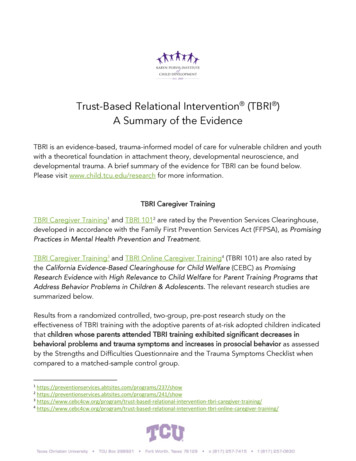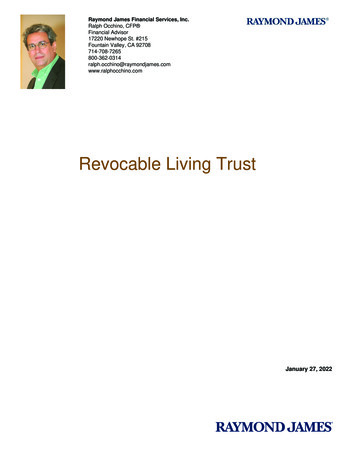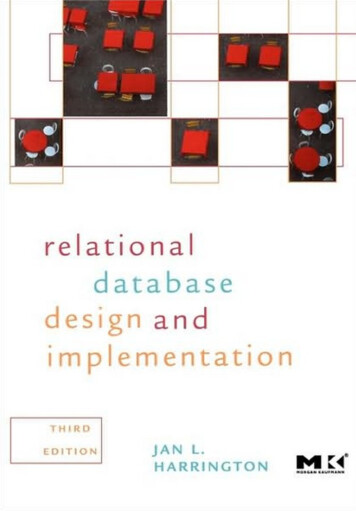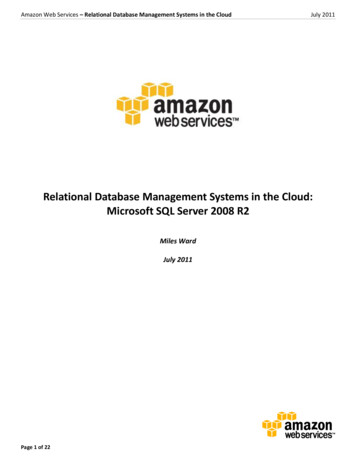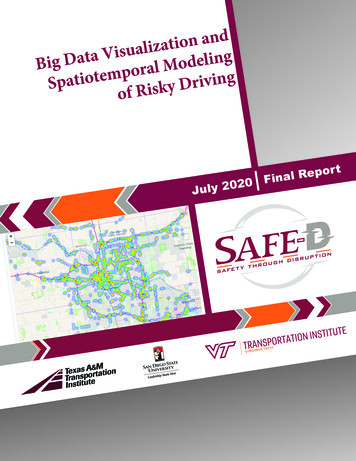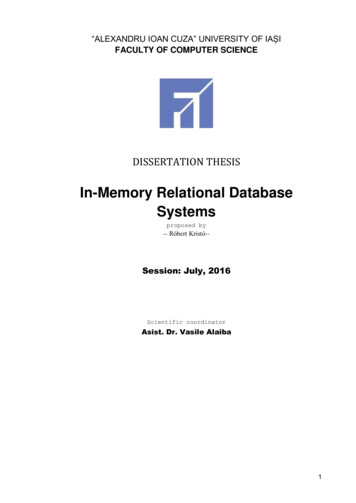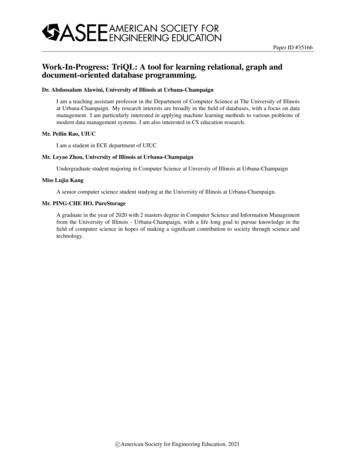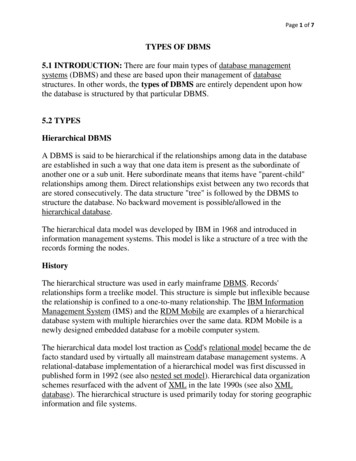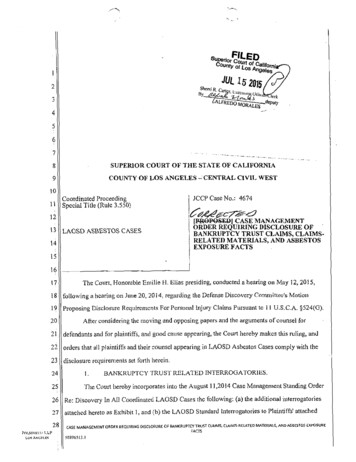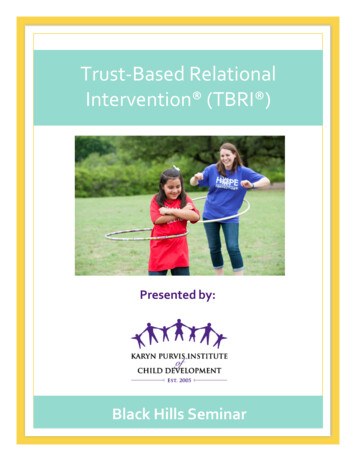
Transcription
Trust-Based RelationalIntervention (TBRI )Presented by:Black Hills Seminar
S TA Y C A L M ( N O M AT T E R W H AT )S E E T H E N E E D ( B E H I N D T H E B E H AV I O R )M E E T T H E N E E D ( F I N D A W AY )D O N ’ T Q U I T ( I F N O T YO U , T H E N W H O ? )
T R U S T- B A S E D R E L AT I O N A L I N T E R V E N T I O NTBRIK A RY N P U RV I S I N S T I T U T E O F C H I L D D E V E L O P M E N T
Copyright 2017 Karyn Purvis Institute of Child Development All Rights Reserved
ContentsTrauma and Traumawise Care9Trust-Based Relational InterventionCreating Healing Connections15Empowering Our Kids to SucceedShaping Our Kids’ BehaviorBibliography25132119
7IntroductionThis notebook was created to serve participants attending the workshop offered by Dr. David Cross on Interpersonal Trauma and TrustBased Relational Intervention (TBRI ), delivered in Rapid City atBlack Hills Seminars, hosted by CF Learning on July 30th, 2017.
Trauma and Traumawise CareInterpersonal Trauma (Victimization)Interpersonal trauma (victimization) is a complex phenomenon thatimpacts children youth in complex ways.1 We summarize the impactof interpersonal trauma on children’s brains in our two diagrams,“Theater of the Mind” (Figure 1) and “Levels of Felt Safety” (Figure 6). Both diagrams are based on Bessel van der Kolk’s The BodyKeeps the Score.2D’Andrea, W., Ford, J., Stolbach, B.,Spinazzola, J., and van der Kolk, B. A.(2012). Understanding interpersonaltrauma in children: Why we need adevelopmentally appropriate traumadiagnosis. American Journal of Orthopsychiatry, 82(2):187–2001van der Kolk, B. A. (2014). The bodykeeps the score: Brain, mind, and body inthe healing of trauma. Viking, New York2
10tbriTrauma and the reness“Timekeeper”“Mohawk ofSelf-Awareness”“Watchtower”Cortical areasare de-activatedCingulateMPFCDLPFCOPFC/MPFCSensory Inputby traumaInsula“Cook”“Smoke Detector”Amygdala isAmygdalaThalamushyper-activatedby trauma“Plumber”HypothalamusHPA SNSLevels ofPNS:DVCFelt-SafetyFigure 1: This “Theater of the Mind”helps summarize and visualize the mostimportant ways that trauma impactsprocessing in the brain and the peripheral nervous systems. Van der Kolk(2014) provided most of the nicknames(e.g., “Timekeeper”), but we addedtwo of our own: “Plumber” and “Electrician.” MPFC Medial PrefrontalCortex; DLPFC Dorsilateral PrefrontalCortex; OPFC Orbital PrefrontalCortex; HPA Hypothalamic-PituitaryAdrenal.
trauma and traumawise care11Safe Havens and the BrainFeels SafeVVCCalm/ExplorePerceived ThreatVVCSeek Safe HavenNo Haven/Immediate DangerSNSFight or FlightNo Escape/Immediate DangerDVCFreeze/CollapseFigure 2: This “Levels of Felt-Safety”diagram summarizes how various situations are processed by child and youth,based on recent work on the polvagalsystem — see The Body Keeps the Score.VVC Ventral Vagal Complex (the“Smart Vagus”); SNS SympatheticNervous System; DVC Dorsal VagalComplex (the primitive vagus).
12tbriThree Pillars of Traumawise Care and ServiceSelf-RegulationConnectionFelt-SafetyTBRI was designed to meet the most pressing needs of children andadolescents who “come from hard places” — their needs correspondto the Three Pillars of Traumawise Care (see Figure 3).3Figure 3: Three Pillars of TraumawiseCare provide a useful framework forconceptualizing and creating interventions for children and youth whohave experienced interpersonal trauma.Connection is the central pillar because both felt-safety and the ability toself-regulate depend on healthy connections. One of the lessons of attachmenttheory and research is that felt-safety inchildren and youth is based on accessto a safe and accessible caregiver (seeFigure 6). Self-regulation developsin the context of safe and comfortingparent-child interactions: First thereis “Other-Regulation,” then there is“Co-Regulation,” and then there is“Self-Regulation.”Bath, H. (2008). The three pillars oftrauma-informed care. Reclaiming Children and Youth, 17(3):17–21; and Bath,H. (2015). The pillars of traumawisecare: Healing in the other 23 hours.Reclaiming Children and Youth, 23(4):5–113Video: Still-Face
Trust-Based Relational InterventionTBRI is based on the sensible idea that effective interventions mustfocus on the whole child — their behaviors, emotions, thoughts, relationships, ecologies, and physiology (see Figure cologicalPhysiologicalStrategiesStrategiesFigure 4: Trust-Based RelationalIntervention (TBRI ) can be divided into three sets of principles: TheConnecting Principles are based onattachment theory, and include Mindful Awareness and the EngagementStrategies. The Empowering Principles help provide a stable platformfor Connecting and Correcting, andinclude the Ecological Strategies andthe Physiological Strategies. The Correcting Principles are designed to helpadults shape behaviors and skills, andinclude the Proactive Strategies and theResponsive Strategies. TBRI is effectivebecause these principles and strategiesimpact the child synergistically to createhealing and well-being.Diamond, A. (2010). The evidencebase for improving school outcomesby addressing the whole child and byaddressing skills and attitudes, notjust content. Early Education and Development, 21(5):780–793; and Purvis,K. B., Cross, D. R., Dansereau, D. F.,and Parris, S. R. (2013). Trust-based relational intervention (TBRI): a systemicapproach to complex developmental trauma. Child & Youth Services,34(4):360–3864EMPOWERINGVideo: Attachment Ritual
Creating Healing ConnectionsIn this part of the workshop, we focus on the Connecting Principles,which are the heart and soul of TBRI (see Figure 4).Mindful AwarenessAs can be seen in Figure 4, Mindful Awareness is the core capacityfor the practice of TBRI; in order to better understand this elusiveconstruct, we list some benefits of mindful awareness:5 fear extinction and modulation; attuned communication; response flexibility; empathy and morality; emotional balance; intuition and insight; regulation of bodily processes.Siegel, D. J. (2009). Mindful awareness,mindsight, and neural integration. TheHumanistic Psychologist, 37(2):137–1585
16tbriEngagement StrategiesThe TBRI Engagement Strategies reflect the importance of nonverbalcommunication6 , and could be considered the “face” of mindfulawareness; the Engagement Strategies include:7Mehrabian, A. (2007). Nonverbalcommunication. Aldine Transaction,Chicago, IL6Purvis, K. B., Cross, D. R., and LyonsSunshine, W. (2007). The connected child:Bring hope and healing to your adoptivefamily. McGraw-Hill, New York7 authoritative voice (tone, volume, cadence), valuing eye contact, behavioral matching, playful interaction, appropriate touch.
creating healing connections17Nurture Groups and the Four SkillsA core TBRI activity is the Nurture Group — Nurture Groups are designed to teach the Four Skills of Close Relationships.8 Nurture Group principles and practices:– Three rules: “Stick together, no hurts, have fun!”9– Core activities: Feeding and band-aids– Life Skill activities (e.g., practice respect with role play)Cassidy, J. (2001). Truth, lies, andintimacy: An attachment perspective.Attachment and Human Development,3(2):121–1558Rubin, P. B. and Tregay, J. (1989).Play with them—Theraplay groups in theclassroom: A technique for professionalswho work with children. Charles CThomas, Springfield, IL9– Self-Regulation activities (e.g., “Engine Check,” “Silly String”) The Four Skills of Close Relationships– Be able to give care– Be able to receive care– Be able to negotiate your needs (e.g., choices, compromises)– Be capable of autonomy — “Autonomy within relationship,relationship within autonomy”Videos: Nurture Groups
Empowering Our Kids to SucceedIn this part of the training, we focus on the Empowering Principles,which provide a foundation for effective Connecting and Correcting(see Figure 4).Ecological StrategiesThe Ecological Strategies are grounded in ecological models of humandevelopment10 — TBRI Ecological Strategies include:11 transitions, touchpoints, completions, artifacts, rituals.Bronfenbrenner, U., editor (2005).Making human beings human: Bioecologicalperspectives on human development. SagePublications, Thousand Oaks, CA; andBronfenbrenner, U. and Morris, P. A.(2006). The bioecological model ofhuman development. In Damon, W.and Lerner, R. M., editors, Handbookof child psychology, volume 1: Theoreticalmodels of human development, pages793–828. John Wiley & Sons10Purvis, K. B., Cross, D. R., Dansereau,D. F., and Parris, S. R. (2013). Trustbased relational intervention (TBRI): asystemic approach to complex developmental trauma. Child & Youth Services,34(4):360–38611
20tbriPhysiological StrategiesThe Physiological Strategies are based on the holistic realization thata child’s social, emotional, and cognitive well-being depends upontheir physical well-being;12 TBRI Physiological Strategies include:13 managing sleep, managing hydration, managing blood sugar, regular physical activity, meeting nutritional needs, healthy touch (e.g., massage), sensory diets (e.g., weighted blankets).Bergman, L. R., Cairns, R. B., Nilsson,L.-G., and Nystedt, L., editors (2000).Developmental science and the holisticapproach. Lawrence Erlbaum Associates,Mahwah, NJ; and Diamond, A. (2010).The evidence base for improving schooloutcomes by addressing the whole childand by addressing skills and attitudes,not just content. Early Education andDevelopment, 21(5):780–79312Purvis, K. B., Cross, D. R., Dansereau,D. F., and Parris, S. R. (2013). Trustbased relational intervention (TBRI): asystemic approach to complex developmental trauma. Child & Youth Services,34(4):360–38613Video: Nutrition Matters
Shaping Our Kids’ BehaviorIn this part of the training we focus on the Correcting Principles, whichbuild on the foundation created by Connecting and Empowering (seeFigure 4).Proactive StrategiesTBRI includes two sets of Correcting (Shaping) strategies — the Proactive Strategies and the Responsive Strategies (see Figure 4); the ProactiveStrategies include the “Life Value Terms” and “Behavioral Scripts:”14Life Value Terms, which are the language of a traumawise culture,15 include: “Gentle and Kind,” “Using Your Words,” “Who’s the Boss?” “With Permission and Supervision,” “With Respect.”Purvis, K. B., Cross, D. R., and LyonsSunshine, W. (2007). The connected child:Bring hope and healing to your adoptivefamily. McGraw-Hill, New York14Purvis, K., Cross, D., Jones, D., andBuff, G. (2012). Transforming culturesof care: A case study in organizationalchange. Reclaiming Children and Youth,21(2)15
22tbriBehavioral Scripts, which are the behaviors of a traumawise culture,16 include: Choices (“You have two choices”), Compromises (“Would you like a compromise?”), Behavioral Re-Do’s (“Can you try that again with respect?”).Abelson, R. P. (1981). Psychologicalstatus of the script concept. AmericanPsychologist, 36(7):715–72916
shaping our kids’ behavior23Responsive StrategiesThe Responsive Strategies are guides for responding to children andadolescents, especially when their behavior is challenging; there aretwo strategies, the IDEAL Response and Levels of Response.The IDEAL Response17 is a general-purpose guide for interactingwith others (see Figure 5); IDEAL Responses are Action-based, whichmeans that the child or adolescent is an active partner in the interaction.IDEALImmediate (3 sec. or less)Direct (Engagement Strategies)Efficient (Levels of Response)Action-based (Behavioral Scripts)Leveled at the behavior,and not the childPurvis, K. B., Cross, D. R., and LyonsSunshine, W. (2007). The connected child:Bring hope and healing to your adoptivefamily. McGraw-Hill, New York17Figure 5: TBRI-based interactions withchildren and adolescents are guided bythe IDEAL Response , which meansthat adult responses are Immediate,Direct, Efficient, Action-based, andLeveled at the behavior, not the child.“Direct” means that adults deploythe Engagement Strategies, discussedabove. “Efficient” means that “We don’tgo after a mosquito with an elephantgun” — we stay at the lowest Levelsof Response possible (see below).“Action-based” means that the childor adolescent is actively involved inlearning, as with the Behavioral Scripts,discussed above.
24tbriLevels of Response18 complement the IDEAL Response, and provide a framework for matching adult responses to the child or adolescent’s behavioral and emotional challenge (see Figure 6).Protective EngagementCalming EngagementStructured EngagementPlayful EngagementPurvis, K. B., Cross, D. R., and LyonsSunshine, W. (2007). The connected child:Bring hope and healing to your adoptivefamily. McGraw-Hill, New York18Figure 6: Levels of Response suggestsa scale, or ladder, of responses corresponding to gradually more seriouschallenges or situations. When thereis no challenge, or there is a slightchallenge, Playful Engagement is appropriate (“Are you askin’ or tellin’?” —said playfully). When there is a mildchallenge, Structured Engagement is appropriate (e.g., “You have two choices”).When emotions are running high, andself-regulation is fragile, then CalmingEngagement is appropriate (“How aboutwe take a walk, and cool down a bit?”).When there is danger, either to thechild, yourself, or someone else, thenProtective Engagement may be appropriate (e.g., SAMA or CPI). As a generalrule, it is best to remain at the lowerlevels whenever possible.Videos: JN & AlexisRSA Animate
BibliographyAbelson, R. P. (1981). Psychological status of the script concept.American Psychologist, 36(7):715–729.Bath, H. (2008). The three pillars of trauma-informed care. ReclaimingChildren and Youth, 17(3):17–21.Bath, H. (2015). The pillars of traumawise care: Healing in the other23 hours. Reclaiming Children and Youth, 23(4):5–11.Bergman, L. R., Cairns, R. B., Nilsson, L.-G., and Nystedt, L., editors(2000). Developmental science and the holistic approach. LawrenceErlbaum Associates, Mahwah, NJ.Bronfenbrenner, U., editor (2005). Making human beings human: Bioecological perspectives on human development. Sage Publications, Thousand Oaks, CA.Bronfenbrenner, U. and Morris, P. A. (2006). The bioecological modelof human development. In Damon, W. and Lerner, R. M., editors,Handbook of child psychology, volume 1: Theoretical models of humandevelopment, pages 793–828. John Wiley & Sons.Cassidy, J. (2001). Truth, lies, and intimacy: An attachment perspective. Attachment and Human Development, 3(2):121–155.D’Andrea, W., Ford, J., Stolbach, B., Spinazzola, J., and van der Kolk,B. A. (2012). Understanding interpersonal trauma in children:Why we need a developmentally appropriate trauma diagnosis.American Journal of Orthopsychiatry, 82(2):187–200.Diamond, A. (2010). The evidence base for improving school outcomes by addressing the whole child and by addressing skillsand attitudes, not just content. Early Education and Development,21(5):780–793.Mehrabian, A. (2007). Nonverbal communication. Aldine Transaction,Chicago, IL.
26tbriPurvis, K., Cross, D., Jones, D., and Buff, G. (2012). Transformingcultures of care: A case study in organizational change. ReclaimingChildren and Youth, 21(2).Purvis, K. B., Cross, D. R., Dansereau, D. F., and Parris, S. R. (2013).Trust-based relational intervention (TBRI): a systemic approach tocomplex developmental trauma. Child & Youth Services, 34(4):360–386.Purvis, K. B., Cross, D. R., and Lyons-Sunshine, W. (2007). The connected child: Bring hope and healing to your adoptive family. McGrawHill, New York.Rubin, P. B. and Tregay, J. (1989). Play with them—Theraplay groupsin the classroom: A technique for professionals who work with children.Charles C Thomas, Springfield, IL.Siegel, D. J. (2009). Mindful awareness, mindsight, and neural integration. The Humanistic Psychologist, 37(2):137–158.van der Kolk, B. A. (2014). The body keeps the score: Brain, mind, andbody in the healing of trauma. Viking, New York.
;TCU Institute of Child DevelopmentSummer 2014Trust-Based Relational Intervention (TBRI )What is TBRI ?Trust-Based Relational Intervention (TBRI) is a holistic, attachment-based, evidence-based andtrauma-informed intervention that is designed to meet the complex needs of vulnerable children.Created by Dr. Karyn Purvis, and Dr. David Cross, Rees-Jones Director of the Karyn Purvis Instituteof Child Development at TCU, TBRI uses Empowering Principles to address physical needs,Connecting Principles for attachment needs, and Correcting Principles to disarm fear-basedbehaviors. TBRI is based on years of attachment, trauma, and neuroscience research, but theintervention has grown out of hands-on work with children who have experienced trauma.Vulnerable children, or children from “hard places,”have changes in their bodies, brains, behaviors, andbelief systems. While a variety of parenting strategiesmay be successful in typical circumstances, childrenfrom hard places need caregiving that meets theirunique needs and addresses the whole child.Although TBRI was designed for children who have experienced some type of abuse, neglect, and/ortrauma, it has proven to be effective with all children. TBRI offers practical tools for parents,caregivers, teachers, or anyone who works with children, to help those in their care reach theirhighest potential.“There is HOPE for children from hard places.TBRI WORKS!” –TBRI PractitionerTrust-Based Relational Intervention can be used in homes, residential treatment facilities, grouphomes, schools, court rooms, camps, and international orphanages.TBRI is taught and utilized across 50 states and 40 countries.Trust-Based Relational Intervention is currently listed on the California Evidence-BasedClearinghouse (CEBC) registry for Child Welfare, and is rated as being “Highly” relevant in the childwelfare system based upon the program being designed to meet the needs of children, youth, andfamilies receiving child welfare services.child.tcu.edu1
;TCU Institute of Child DevelopmentSummer 2014TBRI Professional TrainingWhile TBRI is used by parents and caregivers worldwide, the Karyn Purvis Institute of ChildDevelopment (KP ICD) focuses their time and resources on training professionals who work withchildren and families, in order to achieve greater reach and impact.“TBRI encourages us to practice HUMANITY.”–TBRI PractitionerIf you are a professional and would like to learn about being trained in TBRI, please visit the PurvisInstitute website (child.tcu.edu) for more information on the following TBRI trainings offered –Title of TrainingLength DescriptionPrerequisitesTBRI Snapshot ½ dayA glimpse into relational trauma & TBRIN/ATBRI Overview1 dayA preview of TBRI principles & strategiesN/AA deeper look at TBRI and how to applyits’ principles & strategies in a schoolsettingTBRI PractitionerPhaseThe KP ICD’s “Flagship” training Training1&2This core training experience isdesigned to prepare practitioners for2 Phasesworking with children from hard placesand their families.Phase 1 –5 units of online coursework &10Pre-Trainingweeksparticipation in an Adult Attachment(Online)Interview (AAI) to prepare for Phase 2.Intensive training combining lecture with5 daysPhase 2 –practice; focuses on the application &On-Site Trainingimplementation of TBRI.4, 1-day After successful completion of the TBRITBRI CaregiverTraining Package(6-hour) Practitioner Training, all TBRI Practitioners*Tool to trainmodules may purchase the TBRI Caregiver TrainingPackage, to use to train others within theirothers in TBRIorganization in TBRI.N/ATBRI & Trauma2 daysInformed ClassroomsDesigned for professionalswith comprehensiveknowledge & backgroundin working with at-riskchildren & families. Application 3,500.00 Successful completion ofPhase 1 Must be a TBRIPractitioner 500.00For a list of professionals in your area who have completed the TBRI Practitioner Training, check out the“TBRI Practitioner List” on the Purvis Institute’s website.child.tcu.edu2
Both diagrams are based on Bessel van der Kolk’s The Body Keeps the Score. 2. 2. van der Kolk, B. A. (2014). The body keeps the score: Brain, mind, and body in the healing of trauma. Viking, New York. 10 tbri. Trauma and the Brain. Co
